Without a doubt, El Dorado represents the most siginificant inland natural area in Long Beach. Over 100 acres of natural habitats are maintained within the 400 acre park (the rest of the park being devoted to active and passive recreation).
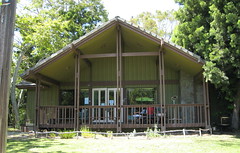
El Dorado Park has a great Nature Center with all sorts of displays and activites for children. They also organize events for adults, such as night-walks and bird ID classes. Unfortunately, the Nature Center has been recently vandalized by some very inconsiderate people. (What kind of person would smash a urinal?)
El Dorado Park is large enough to have honest-to-goodness trails! Three, in fact.
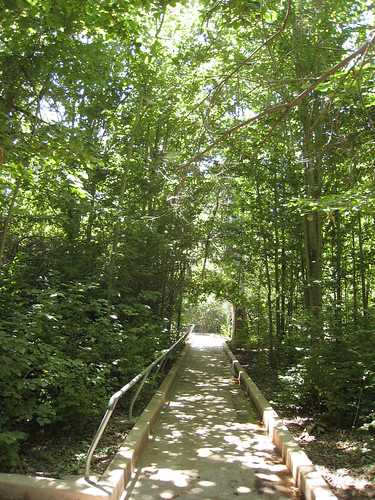
The shortest trail is only 1/4 a mile, and is entirely paved, with railing. This trail winds through a dense forest near the Nature Center, and is completely accessible to wheelchairs.
In forests, trees grow densley, shading out most of the sunlight from the forest floor. (In contrast, there's more space between the trees in a woodland--see below.) Forests are uncommon in the lower elevations of Southern California, because few areas have enough soil moisture year-round.
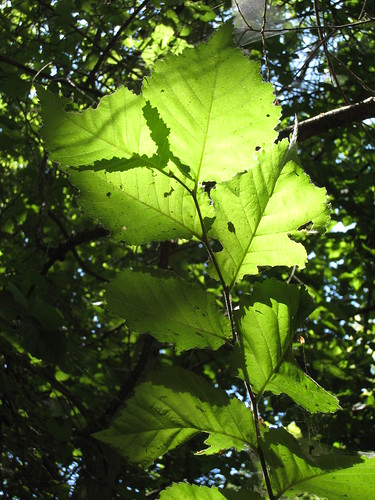
The leaves of this white alder (Alnus rhombifolia) catch what little light makes it through the dense upper canopy of leaves.
The lower levels of a forest is generally full of saplings and vince that get just enough sunlight to keep themselves alive. These plants are waiting for the bigger shade-producing trees to fall over or die, flooding the floor with sunlight. Until then, they simply wait and try to stay alive.
Animal life is bustling here. The thick growths of branches are festooned with spiderwebs, which catch all sorts of insects.
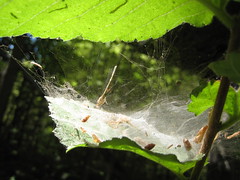
A spider in its web waits for its next meal. The carcass of a damselfly shows that the spider has been eating well.

Western fence lizards (Sceloporus occidentalis are common in nearly every part of the park, but you are most keenly aware of them in the forest, where they rustle loudly in the dried leaves.
The end of the paved trail (or entrance, depending on which way you do the loop) takes you through a small open grassland, where many native wildflowers were recently planted (as well as a few non-native ones, for some reason).
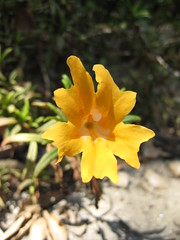
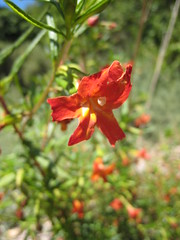
Sticky monkey flower (Mimulus aurantiacus) is one of the showiest native wildflowers. It ranges in color from yellow to red.
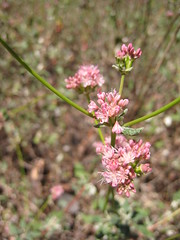
Several species of buckwheat grow in the park. This photo is sea cliff buckwheat (Eriogonum parvifolium). Nearby, you can find California buckwheat (E. fasciculatum, and giant buckwheat (E. giganteum).
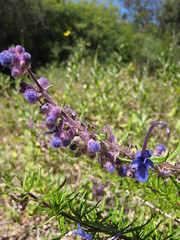
Woolly bluecurls (Trichostema lanatum) has bizarre and striking flowers.
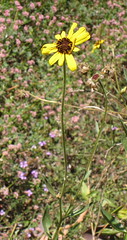
Bush sunflower (California encelia), getting munched by a caterpillar.

Western vervain (Verbena lasiostachys)
There are two longer trails (1 mile and 2 mile), which, though unpaved, are still extremely easy. The longer trail passes through some unshaded areas, so be sure to wear sun protection.
Thanks to its size, touring El Dorado will show you a large variety of habitats: oak woodlands, forest, coastal sage-scrub, grassland, chaparral. In addition, there are several different aquatic habitats: two large ponds, a stream connecting them, plus their fringing wetlands.
All paths take you near the two large ponds in the pond, as well as the stream connecting them.
Turtles are among the most conspicuous wildlife you will see in the ponds.
Turtle floats near the nature center:
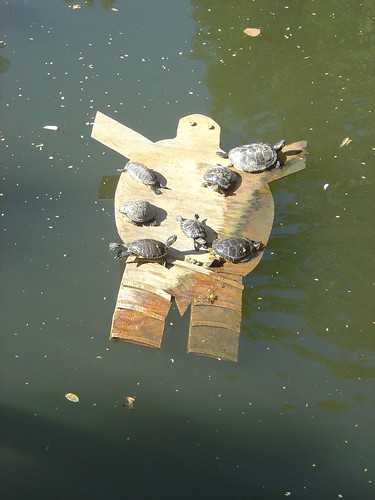
Although the floats may be somewhat garish, they provide excellent basking for the ponds' turtles (mostly exotic red-eared sliders). This allows them to be viewed close to shore by children, but still safe and secure from predators.
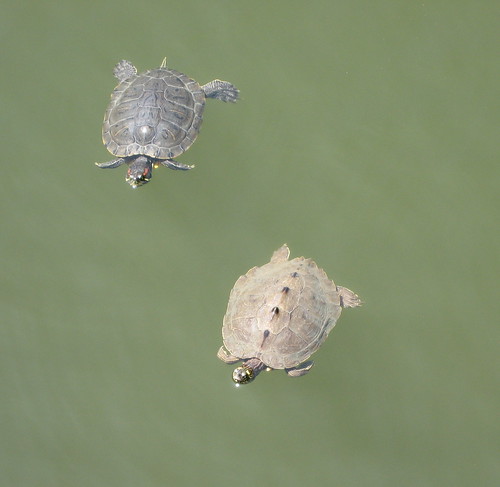
Red-eared slider (Trachemys scripta elegans), left, and Ouachita map turtle (Graptemys ouachitensis), right. Both are nonnative turtles widely sold in the pet trade.
Typically, you will see many red-eared sliders (Trachemys scripta elegans). However, I saw one Ouachita map turtle (Graptemys ouachitensis) among them. Both are probably escaped pets, although the sliders have undoubtedly established a stable population in the park.
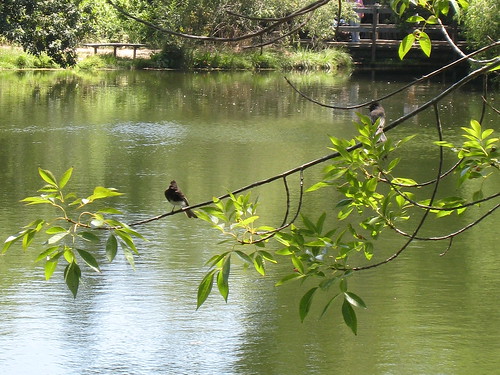
Two black phoebes (Sayornis nigricans) hang out near the water's edge.
Lots of birdlife is attracted to the wetland. Fly-catchers, such as these black phoebes (Sayornis nigricans) perch near the water and catch flying insects "on-the-wing." Pretty impressive to watch!
In addition to the typical wetland cattails, rushes, and sedges, you can find some unusual plants growing near the pond:

Lizard tail, or Yerba mansa (Anemopsis californica)
Oak Woodland:

Coast live oaks (Quercus agrifolia) intersperse with willows, alders, and other trees and shrubs to form small, open woodlands. Unlike a forest, woodlands have well-spaced trees, and it is generally easy to see through the vegetation. Smaller herbaceous plants may grow densely in the understory.
Coastal sage-scrub
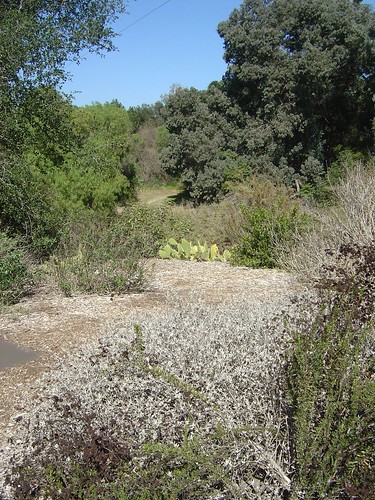
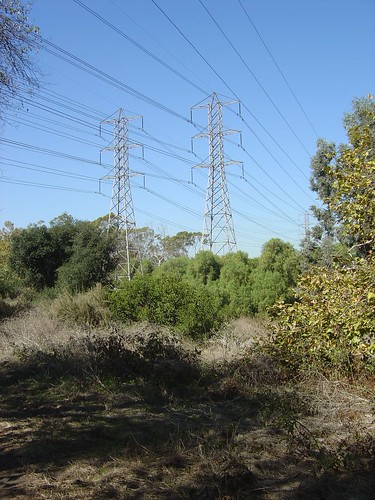
Southern lake, with fringing wetlands and plenty of coots, ducks, and other waterfowl:

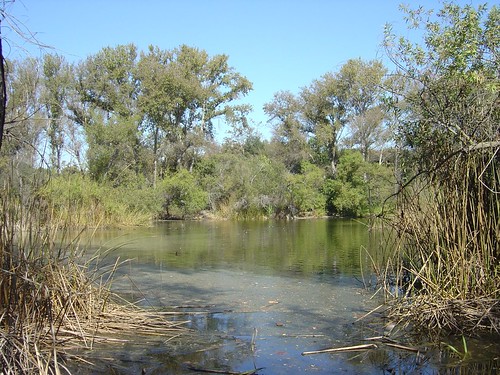
Toyon, or holly (Heteromeles arbutifolia:
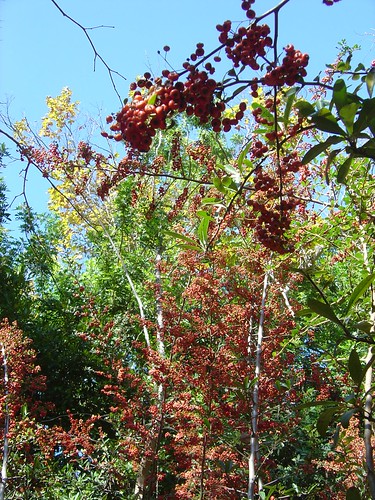
The El Dorado chapter of the Audubon Society maintains a check-list of birds for this park.
Although much of the park has native vegetation, there are quite a few nonnative ornamental plants too. I'm not sure if the nonnatives that have been planted are considered invasive and a threat to Long Beach's wildlands, but I would prefer if the park remained a sanctuary for the native plants of California.
Plans are in development to create treatment and habitat wetlands in the more developed portions of El Dorado between Carson Street and Spring Street. This project would expand wetland and riparian habitat in the park, and prevent pollution from entering the San Gabriel River.
To get to the Nature Center, take the 102 bus (M-F) or the 173, and walk east down Spring Street from Studebaker.
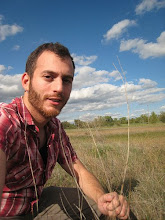

8 comments:
The link to El Dorado Audubon is outdated. Try eldoradoaudubon.org
The link to El Dorado Audubon is outdated. Use eldoradoaudubon.org instead and be happy
I've walked the trails at the Nature Center for almost 40 years. The nature center is not a natural habitat, but was completely man-made in the 1950's, including the ponds. At that time, the focus was not so much on plant species native to Southern California. I've spoken with a naturalist at the Center, and the emphasis now is on native plants. Some of the non-native species have been removed, and whenever there is re-planting of an area, the plants are native. I've seen rabbits (some, I'm sure, are released pets), coyotes, a gopher snake, gophers, Great Blue Herons, egrets, osprey, hawks, falcons, mallards, and numerous other waterfowl at the park over the years, in addition to the many insect species! Unfortunately, I recently found out that the Nature Center uses the herbicide RoundUp to control some of its unwanted plants; this is largely due to a lack of funding from the city of Long Beach to hire more personnel to take care of the park in a more sustainable manner.
On Monday Oct 27 I saw a large bird in Eldorado Park North,near the old ranger station, it was chomping on something on the ground, than flew into a tree. It was huge,I first thought it was a golden eagle,but it also could have been a young bald eagle.In the best tradition of UFO nuts I did not have a camera with me!
Hmm... an eagle would be truly remarkable to see in El Dorado. Do you think it might have been a red-tailed hawk? They are very large and impressive birds, but much more common in the area.
Thank you for the impressive site dedicated to Long Beach natural areas. If you have any questions about the Nature Center please feel free to contact the Supervisors or Naturalist Staff at 562-570-1745. And it has been confirmed that the large birds seen in El Dorado Regional Park are juvenile bald eagles.
It's a great place to run around naked. There are offshoots to the main trails with areas that are private enough yet large enough to roam freely. Pretty cool! Just don't let the ranger catch you in your birthday suit!
KermitGoogle is WRONG.
I have no problem with public nudity. But I strongly disagree that there is any part of El Dorado park private enough that you can avoid running into people. In fact, there isn't a single part of Long Beach where this behavior would be appropriate.
You are very likely to get arrested if you follow his advice.
There are better places to explore nature al fresco than Long Beach.
Post a Comment